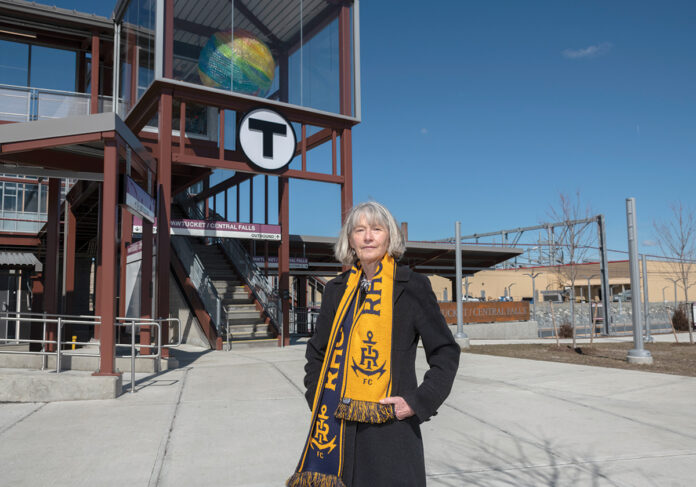The long-awaited Pawtucket-Central Falls Transit Center is finally here, and many agree it’s been a success so far.
The new transit center – comprised of a brand-new train station and bus hub – debuted on Jan. 23, after almost five years of construction. Born out of a collaboration between the R.I. Department of Transportation, the R.I. Public Transit Authority and the cities of Pawtucket and Central Falls, the $63 million project connects commuters to the Massachusetts Bay Transit Authority’s commuter rail line and to RIPTA’s bus network.
Since it opened over a month ago, commuters have made good use of it.
“We’re very happy with what we’ve seen from demand, it’s very encouraging and welcome news,” said Charles St. Martin, spokesperson for RIDOT. “We had plans for a multi-mobile center and the public is embracing it in the way we had envisioned.”
The train station, located at 300 Pine St. in Pawtucket, sees about 400 boardings daily, St. Martin said, while the bus hub, serving 10 bus routes, has seen 7,899 total boardings during the month of February, RIPTA said.
Construction for the project broke ground in the winter of 2018, led by Massachusetts-based Barletta Heavy Division Inc., which was awarded the design and construction project through a request for proposals. It includes platforms for northbound and southbound service, connected by a glass-enclosed pedestrian bridge, elevators, ramps and stairs.
“It’s modern, it’s classy, it suggests security and safety,” said Jan A. Brodie, executive director of the Pawtucket Foundation. “It makes the city shine.”
Riding the wave of this success, both RIDOT and RIPTA are making plans to further enhance the center.
The station’s current parking lot, featuring 200 spots, is at full capacity almost every morning, St. Martin said. To meet this demand, the department is expanding the parking lot and doubling the number of parking spaces by the end of the year.
RIPTA, on the other hand, is expanding its hub with a new amenity building, which will feature public restrooms, driver restrooms, a break room, a Pawtucket Police substation and security office, an interior waiting area with seating, device charging stations, and real-time passenger information screens. The facility is expected to be designed before the end of 2023, said Cristy Raposo Perry, spokesperson for RIPTA, and it will be funded using $5 million allotted in Gov. Daniel J. McKee’s fiscal 2023 budget.
“The more convenient public transit is, the more people are likely to leave their cars behind – especially here in Pawtucket and Central Falls,” Raposo Perry said. “This new transit center, featuring both bus and rail, enables people from all over the state to easily make the connection to rail travel.”
The new station marks the first time in more than 50 years that Pawtucket and Central Falls residents have access to a train station close to their homes. Until January, commuters had to travel to either Providence or Attleboro to board the commuter rail, especially since the 2021 closure of the South Attleboro station.
“Transportation and access are essential to businesses, residents, commuters,” Brodie said. “It’s a state, regional and city asset.”
But the station is much more than a point of access for public transit: it has the potential to work as a conduit for real estate and economic development in the surrounding area. Placed between the cities of Pawtucket and Central Falls, in what is known as the Conant Thread District, the station is already attracting developers and investors.
“Part of our strategy was to support our area and create a transit connect for everyone, as well as support economic development,” St. Martin said. “We’re seeing that happening.”
Conant Thread, a 150-acre area surrounding the station in Pawtucket, along the border of Central Falls, has long been looked at with hopeful optimism from the two cities as a potential hub for development.
With more than 4 million square feet of pre-permitted development opportunities, including 2 million square feet of vacant or underutilized historic mill space and another 2 million square feet of vacant land for new construction, the district offers the perfect investment opportunity. This is in addition to another 4 million square feet of development opportunity in downtown Pawtucket, said Pawtucket Mayor Donald R. Grebien.
A fire in 2020 set back redevelopment plans, severely damaging several old mills in the area. While some of them are irredeemable, Brodie said, the rest can be reinvented to house more apartment units or commercial spaces.
“Those historic, beautiful old mills are gone,” Brodie said. “Fortunately, all the others are still standing, and I don’t think there are any that haven’t gotten the attention of investors with different ideas for revitalization.”
This optimism is not misplaced. In recent years, the area attracted a lot of renewed attention, especially ahead of the transit center’s opening.
“We have 800-1,000 units of apartment housing that have either been built, are in the process of final financing or are under consideration for permitting,” Brodie said. “It’s exciting.”
Now that the train station is here, more opportunities for both commercial and residential developments are likely to follow. Brodie said the hope is that there will be a continued focus on mixed-income housing and more commercial developments.
In the meantime, congressional funds have been coming in. Sens. Jack Reed, D-R.I., and Sheldon Whitehouse, D-R.I., last year invested over $3 million in funding for access to the new transit center and neighboring areas.
“Transportation never goes away and COVID proved how important it is to give access to people,” Brodie said. “We’re hoping it becomes a real transit center for both folks going north and those going south.”













